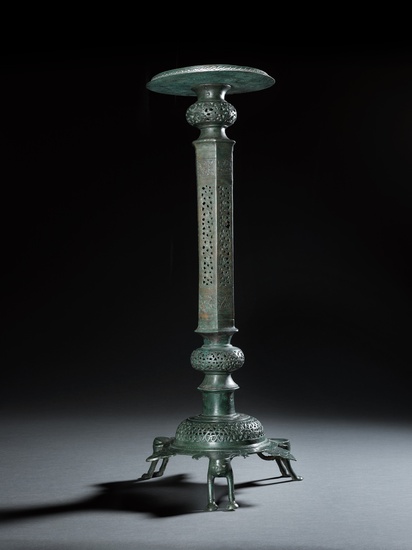A large Khurasan bronze lampstand, Eastern Persia, 12th century
consisting of three interlocking parts, including an openwork domed tripod base on zoomorphic legs, a vertical hexagonal shaft pierced with interlacing strap work and openwork globular bulbs at each end, surmounted by a flat tray incised with interwoven patterns
83.5cm.
Condition Report:
Some erosion and oxidation to the surface as consistent with age, the tray with small near the border and chips along the edge, one of the feet on the base broken with associated restoration, as viewed.
Catalogue Note:
The unique features that characterise medieval Persian lampstands owe their origins to ancient Byzantine prototypes. While earlier Islamic examples were of rather rudimentary craftsmanship, typically made of ceramic materials with sparse adornment (see E. Baer 1983, p.12), subsequent iterations such as the present specimen display the innovative spirit of Khurasani metal workshops. The present example's hexagonal central shaft, zoomorphic tripod base, and intricately perforated body are so many intrinsically Persian elements, which would remain in fashion in the Islamic world until the fourteenth century (ibid., p.17).
A closely similar example is in the Islamic Arts Museum, Malaysia (ed. Fong Peng Kuan, 2002, p.250).
Provenance:
Sotheby's, London, 24 October 2007, lot 100
View it on
Estimate
Time, Location
Auction House
consisting of three interlocking parts, including an openwork domed tripod base on zoomorphic legs, a vertical hexagonal shaft pierced with interlacing strap work and openwork globular bulbs at each end, surmounted by a flat tray incised with interwoven patterns
83.5cm.
Condition Report:
Some erosion and oxidation to the surface as consistent with age, the tray with small near the border and chips along the edge, one of the feet on the base broken with associated restoration, as viewed.
Catalogue Note:
The unique features that characterise medieval Persian lampstands owe their origins to ancient Byzantine prototypes. While earlier Islamic examples were of rather rudimentary craftsmanship, typically made of ceramic materials with sparse adornment (see E. Baer 1983, p.12), subsequent iterations such as the present specimen display the innovative spirit of Khurasani metal workshops. The present example's hexagonal central shaft, zoomorphic tripod base, and intricately perforated body are so many intrinsically Persian elements, which would remain in fashion in the Islamic world until the fourteenth century (ibid., p.17).
A closely similar example is in the Islamic Arts Museum, Malaysia (ed. Fong Peng Kuan, 2002, p.250).
Provenance:
Sotheby's, London, 24 October 2007, lot 100



